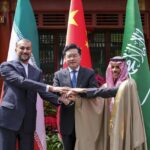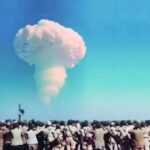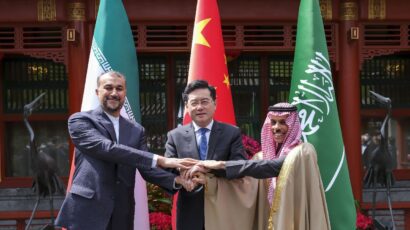Involuntary response
By Fissile Materials Working Group | January 26, 2012
Earlier this month, widespread inaction on the increasing dangers posed by nuclear proliferation and climate change forced the Bulletin‘s Doomsday Clock to move one minute closer to midnight, indicating the mounting perils confronting humanity’s survival. One factor pushing the clock forward to five minutes to midnight was the failure to ensure strict security and comprehensive international oversight for nuclear weapons and materials, which continue to accumulate in a few nations. Despite several ongoing initiatives to strengthen global defenses against nuclear terrorism, it is clear that much more needs to be done to ensure that the nightmare doesn’t become reality.
In April 2010, 47 heads of state met in Washington, DC, for the first Nuclear Security Summit in order to find ways to address the largely overlooked threat of nuclear terrorism. The summit was the largest meeting of heads of state called by an American president since 1945, when leaders gathered in San Francisco in the effort that launched the United Nations. Major obstacles confronted planners for the first Nuclear Security Summit, including a lack of consensus on the dangers of nuclear terrorism and how best to enhance global nuclear security (problems that still persist). By gathering world leaders — rather than bureaucrats — to address the issue head on, the first summit made some important steps in helping to raise global awareness about the threat of nuclear terrorism. The 47 heads of state, representing countries from all corners of the globe, concluded in a nonbinding communiqué that “nuclear terrorism is one of the greatest threats to global security” and that “strong nuclear security measures” are the best means to prevent the threat from becoming reality. Additionally, the leaders joined President Obama’s goal to secure all vulnerable nuclear material within four years.
In addition to the strong normative support generated for preventing nuclear terrorism, the 2010 Nuclear Security Summit resulted in approximately 50 concrete national commitments to strengthen global nuclear security — many of which have already been fulfilled heading into the second summit this March in Seoul, South Korea. Of particular note are the pledges to eliminate nuclear bombmaking materials. Since April 2010, nearly 400 kilograms of highly enriched uranium (HEU) has been removed from 10 countries. Russia, meanwhile, has destroyed more than 48 metric tons of HEU, with the United States eliminating seven additional metric tons of HEU. Such measures reduce the amount of material that could slip onto the black market and into the wrong hands. Other states, meanwhile, helped to bolster the international legal framework for nuclear security, with 13 additional countries ratifying the amendment to the Convention on the Physical Protection of Nuclear Materials and 12 ratifying the International Convention for the Suppression of Acts of Nuclear Terrorism. Several states made additional contributions to the Office of Nuclear Security of the International Atomic Energy Agency (IAEA), thus increasing the resources of an organization that provides vital guidance on how nations can best enhance their nuclear security.
Yet, while the first Nuclear Security Summit greatly enhanced international attention on the threat of nuclear terrorism and gained tangible commitments, it is evident that much more work remains to ensure that all nuclear materials are secure. In 2009, the Fissile Materials Working Group (FMWG), a coalition of nongovernmental organizations dedicated to preventing nuclear terrorism, released a set of five consensus policy recommendations:
• Launch a new “Next Generation Nuclear Security Initiative.”
• Accelerate efforts to consolidate and eliminate global HEU, plutonium, and nuclear weapons stockpiles.
• Minimize all forms of HEU use and set a timetable for a ban on the civil use of HEU.
• Request and aggressively pursue sufficient funding for removing and securing all vulnerable nuclear materials around the world in four years.
• Extend and expand the G-8 Global Partnership Against the Spread of Weapons of Mass Destruction for another 10 years.
Despite strong international expert consensus on the nature of the threat, the FMWG’s original policy recommendations still remain largely applicable two years after they were released. Unfortunately, governments and citizens don’t seem to recognize the urgency of the problem, and a detailed plan for securing all vulnerable nuclear materials has yet to be created. And, while significant progress has been made to secure fissile materials around the globe, there is enough military and civilian HEU in the world to produce another 60,000 nuclear weapons — without considering stockpiles of plutonium — according to the International Panel on Fissile Materials. Plus, the future budget outlook for the United States and Europe is grim, potentially jeopardizing funding for vital programs that secure nuclear materials around the globe.
The current nuclear security regime, meanwhile, may not be adequate to prevent potential terrorists from acquiring nuclear material and constructing a crude nuclear device. Kenneth Brill, former US ambassador to the IAEA, argues that the “existing global architecture for nuclear security is more like a shantytown than a coherent structure.” Nuclear security remains a national responsibility, with very little international oversight, peer review, or enforcement measures. According to Brill:
“The existing pastiche of niche treaties, like-minded initiatives, and IAEA recommendations give the appearance of dealing effectively with nuclear security, while the reality is the ‘best efforts’ and voluntary nature of virtually all international action on nuclear security leave loopholes through which a determined terrorist group could drive one or more improvised nuclear devices.”
Given the international ramifications of a nuclear terrorist attack, it seems that a regime relying on voluntary national commitments is inadequate, particularly when governmental consensus on the nature of the threat can be uneven and fleeting.
The 2012 Nuclear Security Summit in Seoul, however, offers the opportunity to take vital steps toward a revitalized and more comprehensive nuclear security regime. In advance of the summit, the FMWG has released two new policy recommendations to further the goal of enhancing global nuclear security. First, the FMWG recommends enhancing the IAEA’s role in promoting global nuclear security. Currently, the IAEA plays a valuable role in providing guidance and assistance on a voluntary basis to nations interested in improving their nuclear security. However, the guidelines and recommendations issued by the IAEA’s Office of Nuclear Security are nonbinding. Increasing the frequency at which International Physical Protection Advisory Service missions or related peer reviews are conducted will enhance the IAEA’s ability to identify nuclear security gaps and recommend improvements. Furthermore, increasing the portion of the Office of Nuclear Security’s activities that receive predictable funding through the IAEA regular budget, in addition to increasing the total amount of voluntary contributions, will buttress its ability to help nations strengthen nuclear security safeguards.
Second, the FMWG recommends strengthening the nuclear security regime through a framework convention that institutionalizes comprehensive standards of performance and responsibility. The serious, international nature of the nuclear terrorist threat warrants stronger action to ensure that nations responsibly protect their nuclear materials. Such a convention would establish binding baseline standards of performance for nuclear security, reinforce the IAEA’s role in providing nuclear security guidance and assistance, and make the IAEA the convention’s executive agent to monitor and evaluate implementation of nuclear security standards and requirements. Furthermore, the convention would fill gaps in the regime while reducing overlap and enable vital but limited information sharing to boost confidence. The FMWG recommends that the framework agreement be in place by 2020 — if not sooner.
While some may question the ability of the international community to agree on a convention that establishes binding nuclear security requirements that still have teeth, acquiescence in the face of such a serious threat is not an option. The Nuclear Security Summit process has drawn unprecedented attention to an issue that has long lingered in obscurity. The world leaders gathered in Seoul need to fully capitalize on this window of opportunity to establish far-reaching changes that ensure universal adherence to common-sense nuclear security measures. The clock is ticking. The time for action is now.
Editor’s Note: This column was written by Ryan Costello, coordinator of the Fissile Materials Working Group at the Connect U.S. Fund.
Together, we make the world safer.
The Bulletin elevates expert voices above the noise. But as an independent nonprofit organization, our operations depend on the support of readers like you. Help us continue to deliver quality journalism that holds leaders accountable. Your support of our work at any level is important. In return, we promise our coverage will be understandable, influential, vigilant, solution-oriented, and fair-minded. Together we can make a difference.
Topics: Columnists, Nuclear Weapons















